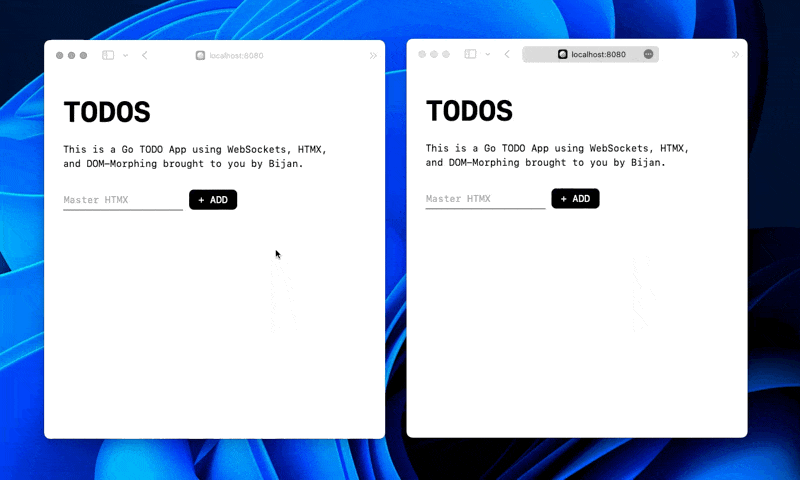Go, WebSockets, HTMX, and DOM Morphing is fun
Introduction
Real-time updates in web applications are a common requirement. Whether it’s a chat application, a dashboard, or a game, users expect to see changes in real-time without having to refresh the page manually. This can be achieved using WebSockets, but it often requires a lot of boilerplate code and can be difficult to implement correctly. In this blog post, we will explore how Go, WebSockets, HTMX, and DOM Morphing can make it easier to build real-time applications.
The Problem
Traditionally, real-time updates using WebSockets involve sending raw data from the server to the client, which then updates the DOM accordingly. However, this approach can be inefficient and may require refreshing the entire page. We wanted to find a more efficient way to handle real-time updates, inspired by the concept of DOM morphing. DOM morphing involves sending a new DOM from the server to the client, which then surgically applies the necessary changes to the existing DOM. This approach is more efficient because it only modifies what is necessary and leaves the browser state intact.
HTMX: Simplifying DOM Morphing in Go
HTMX is a powerful library that simplifies the implementation of DOM morphing in Go applications. It handles all the details of managing the WebSocket connection and applying the changes to the DOM. With HTMX, developers can easily build real-time applications without having to write complex WebSocket code or worry about managing the DOM updates manually.
Building a TODO App with Go, WebSockets, HTMX, and DOM Morphing
To demonstrate the feasibility of this tech stack, we built a simple TODO app using Go, WebSockets, HTMX, and DOM Morphing. The app allows users to create and update tasks in real-time, and it supports multiple users, ensuring that changes made by one user are reflected in the UI for other users. You can see the app in action here:

The source code for this tech-demo is available on GitHub: https://github.com/gobijan/go-htmx-todo
Why Choose Go for Real-Time Applications?
Go is an excellent choice for building real-time applications for several reasons. First, Go is known for its simplicity and efficiency. It has a small and concise syntax, making it easy to read and write code. This simplicity translates into faster development cycles, allowing developers to deliver high-quality solutions in a shorter timeframe.
Second, Go’s performance is exceptional. It is a compiled language designed to be fast and efficient. Go’s lightweight goroutines and built-in concurrency support enable developers to handle high loads and scale applications easily. This makes it an ideal choice for building robust and scalable real-time applications.
Additionally, Go has a strong standard library and a vibrant ecosystem of third-party packages. This provides developers with a wide range of tools and libraries that can accelerate development and enhance functionality. Whether it’s handling HTTP requests, working with databases, or implementing authentication and authorization, Go offers the necessary tools to build secure and reliable real-time applications.
Work With Us
At Screen Island, we have extensive experience in building APIs and backends using various tech stacks, including Go, WebSockets, HTMX, and DOM Morphing. We believe in using the best tools for each project based on its specific requirements and constraints. Our diverse skill set, which includes expertise in Ruby on Rails and C# with Dotnet, allows us to make informed decisions and deliver optimal solutions.
If you’re looking for a team with extensive experience in building real-time applications using Go, WebSockets, HTMX, and DOM Morphing, Screen Island is here to help. Contact us today to discuss your project requirements and let us bring your ideas to life.